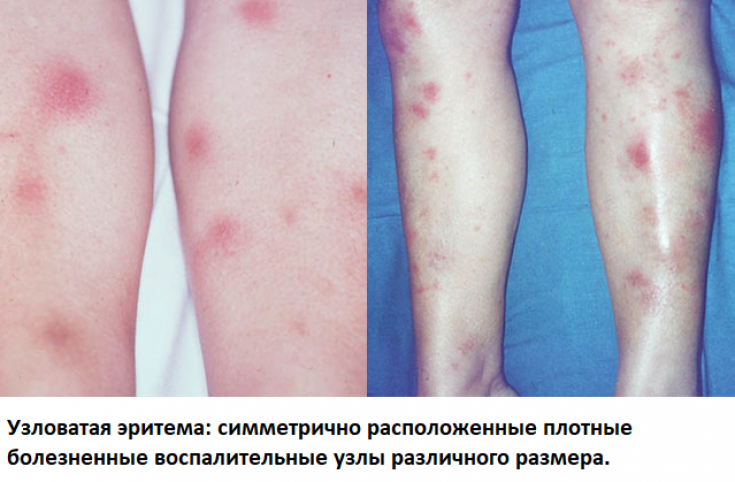Erythema nodosum is a pathological condition caused by a hypersensitivity reaction and characterized by the development of sensitive, erythematous, deep-seated and immobile nodules on the skin.
Erythema nodosum is more prone to women – they have the disease about 5 times more often than men.
The shins are a favorite site for erythema nodosum, but lesions can also be found on the thighs, buttocks, upper extremities, and face. In some cases, erythema nodosum is accompanied by fever and joint pain, which can be the cause of diagnostic errors.
In this article on estet-portal.com read about trigger factors that can lead to the development of erythema nodosum, as well as about modern principles of managing a patient with this pathological condition.
The most common causes of erythema nodosum
Various trigger factors can lead to the development of erythema nodosum. Among them, the most important are:
1. Rheumatic diseases;
2. Tuberculosis;
3. Sarcoidosis;
4. Yersiniosis;
5. Infectious mononucleosis;
6. Streptococcal infection (including streptococcal tonsillitis);
7. Behçet's disease;
8. Coccidioidomycosis;
9. Medications.
However, 60% of cases of erythema nodosum are idiopathic. As a rule, the nodes resolve on their own after an average of 8 weeks after their appearance. The diagnosis is established clinically, but in some cases a biopsy may be required.
It should be remembered that erythema nodosum most often develops in women aged 20-40 years.
Follow us on Facebook
What investigations should be done in a patient with erythema nodosum
Erythema nodosum can be a symptom of serious medical conditions, such as streptococcal infections, sarcoidosis, and tuberculosis.
Therefore, all patients with erythema nodosum should be investigated to determine the cause of this condition.
They include:
1. Complete blood count;
2. Determination of the level of ASLO (antistreptolysin-O) – the analysis must be repeated 2-4 weeks after the initial study;
3. Tuberculin test;
4. Chest x-ray.

Skin biopsy is appropriate in cases of atypical location or appearance of erythema nodosum. It is necessary in order to distinguish erythema nodosum from eczematous panniculitis, nodular vasculitis, Weber–Christian disease, superficial thrombophlebitis in doubtful cases.
Erythema annulare treatment: the most effective methods
Erythema nodosum: current principles of disease management
In most cases, erythema nodosum does not require specific treatment – rashes completely resolve themselves in 1-2 months.
In cases where the patient complains of joint pain, the doctor should recommend bed rest, placing the legs on a raised platform, and taking non-steroidal anti-inflammatory drugs.
In the management of erythema nodosum, the main task of the attending physician is to determine the cause leading to the development of this condition, and subsequently treat the underlying disease.
Erythema nodosum: why diagnosing the underlying disease is important
Drug treatment of erythema nodosum: when appropriate
In some cases, erythema nodosum may bother the patient for a long time, without tending to resolve itself.
If a patient reports persistent symptoms of erythema nodosum for a long time, international guidelines recommend the administration of potassium iodide at a dose of 300 mg (6 drops) orally 3 times a day.
It is worth remembering the possible side effects of potassium iodide, in particular, hypothyroidism and hyperkalemia.
Thank you for staying with estet-portal.com. Read other interesting articles in the "Dermatology" section. You may also be interested in Erythema annulare: what does the appearance of red rings on the skin indicate







Add a comment